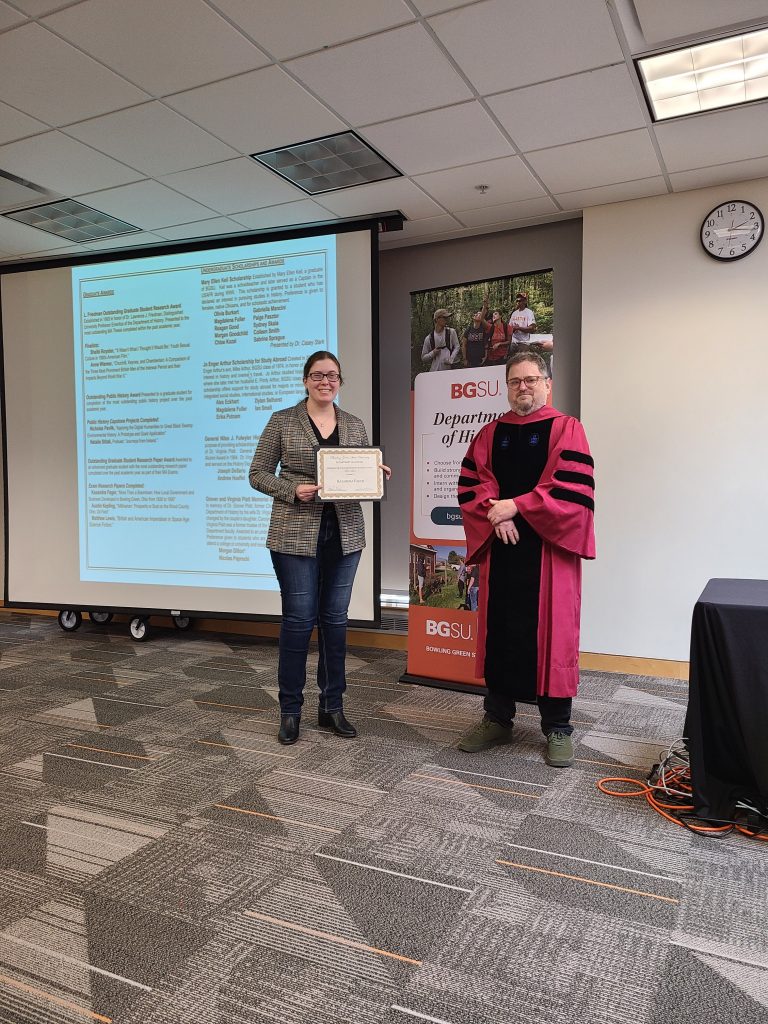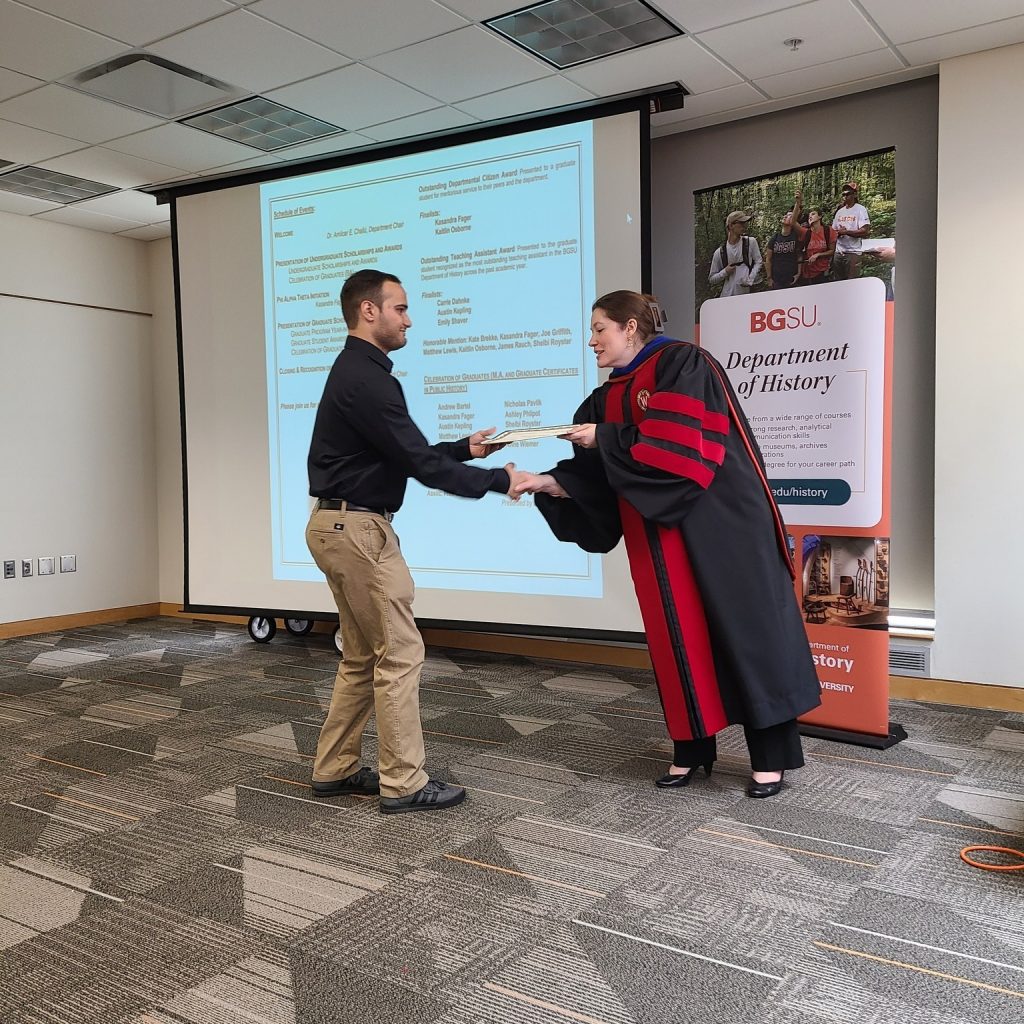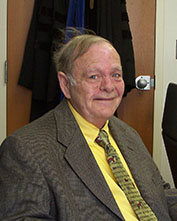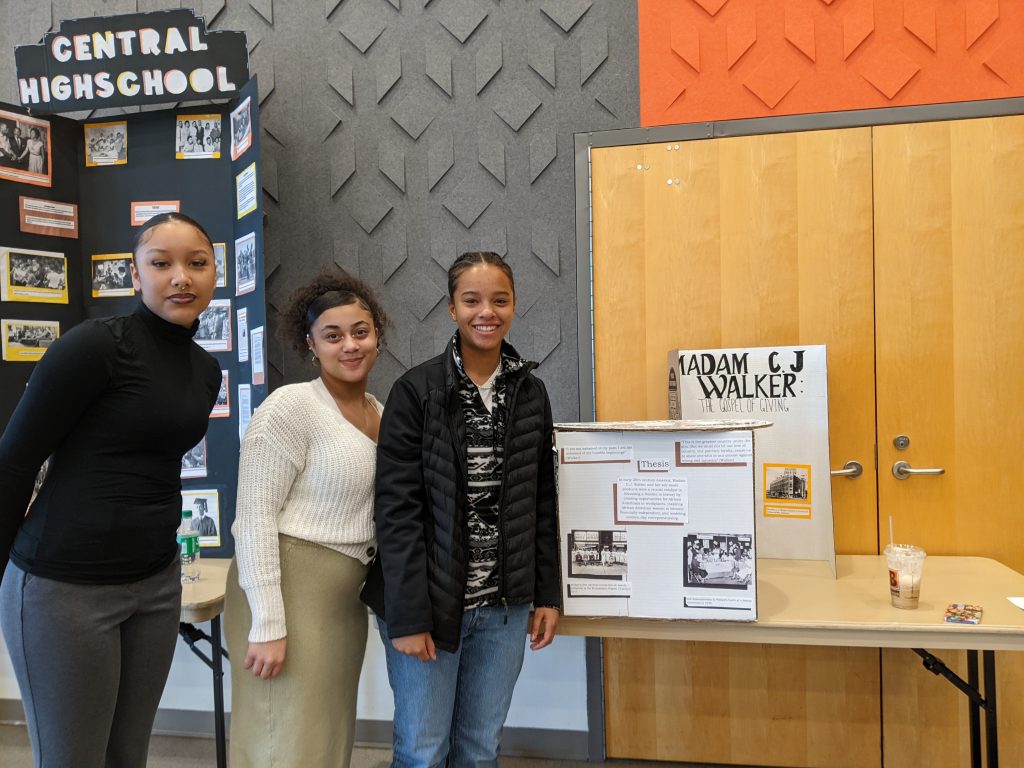Fall 2023 Course Offerings
02 Friday Jun 2023
Posted in Department News
≈ Comments Off on Fall 2023 Course Offerings
02 Friday Jun 2023
Posted in Department News
≈ Comments Off on Fall 2023 Course Offerings
11 Thursday May 2023
Posted in Awards, Graduate Student News
≈ Comments Off on 2023 Graduate Student Awards
Tags
BGSU History, Lawrence Friedman Outstanding Graduate Student Research Award, Oustanding TA Award, Outstanding Departmental Citizen Award, Outstanding Public History Project, Senior Graduate Student Distinguished Research Award, Student Awards

For more information on previous award winners, see this link.
Continue reading11 Thursday May 2023
Posted in Awards, Undergraduate Student News
≈ Comments Off on 2023 Undergraduate Awards Winners
Tags
BGSU History, Donna M. Neiman Award for Undergraduate Research Excellence, General Niles J. Fulwyler History Scholarship, Grover and Virginia Platt Memorial Scholarship, Jo Enger Arthur Scholarship for Study Abroad, John Schwarz Essay Award, Mary Ellen Kiel Scholarship, Outstanding Senior in History Award, Stuart R. and Florence P. Givens Senior History Scholarship, Student Awards

To learn more about previous undergraduate awards winners, see this link.
Continue reading10 Wednesday May 2023
Posted in Awards, Capstone, Undergraduate Student News
≈ Comments Off on Ireland’s Easter Rising of 1916: A Troubled Revolution
Tags
20th century history, BGSU Historu, Braxton Howard, Donna M. Neiman Award, Easter Rising, Ireland
By: Braxton Howard, 2023 Award Winner of the Donna M. Neiman Award, Senior History Major
This is a public presentation of a paper originally written for HIST 4805: Revolutions in World History, taught by Dr. Michael Brooks. Although shortened to the essentials, this post aims to outline the ways that the relatively short Easter Rising of 1916 could bring to light divides that had grown among the Irish people, which would bring over a century of contention exhibited not only through a war for independence and the Troubles, but also equally contentious works of history. These divisions – an intertwined mixture of views on British rule and religious belief – would come to a boiling point as frustrations with the British grew in reaction to representation issues, the Irish Famine in the 1840s, and, at the time of the Rising, World War I drafts. Religion had long been a point of conflict among the Irish, with British attempts to convert them to Protestantism, often by force, occurring regularly and finding the most success in Northern Ireland.

08 Monday May 2023
Posted in Emeritus News
≈ Comments Off on In Memory of Professor Emeritus Dr. James H. Forse
Tags

Dr. James Forse was a member of our department for 44 years and retired in 2010. The department sends our support and love to his family, friends, and former students.
If you wish to share a memory of Dr. Forse with his family, please see this link.
Dr. Forse’s research and teaching focus was on Medieval and Renaissance Europe. He was the author of Art Imitates Business: Commercial and Political Influence in Elizabethan Theatre (Bowling Green State University Press, 1993), and published articles which have appeared in German History, The Journal of Medival History, SRASP, Journal of Popular Culture, and Theatre Survey .
05 Friday May 2023
Posted in Phi Alpha Theta
≈ Comments Off on We Are Not Throwing Away Our Shot!
Tags
BGSU History, Chicago, Emily Shaver, Kasandra Fager, Oluwatimilehin Fatoki, Phi Alpha Theta, Rachel Miller
By Kasandra Fager and Emily Shaver
Imagine! Four BGSU students jamming out to Hamilton on the home way from Chicago singing about immigrants, truth, and democracy. This musical is found in any historian’s collection, but there is more to it than just a piano and a sheet of music. The silences and difficult topics that are revealed in this musical are the same themes that were revealed in our trip to Chicago. Like they say, “History Has Its Eyes on You” and we certainly took that to heart!
Over Spring Break, four history graduate students traveled to Chicago to embark on a 72-hour public history experience. Supported by the department’s student organization, Phi Alpha Theta, and BGSU’s Student Engagement Office, they visited the Chicago History Museum, the Field Museum of Natural History, and the Illinois Holocaust Museum. We may have lost our way as we tried to find the parking lot near our hotel and visited the bean in the rain, but we made it to the other side with Giordano’s deep-dish pizza in our stomachs and a new appreciation for Chicago’s history.
Continue reading03 Wednesday May 2023
Posted in Events, Professional Development
≈ Comments Off on Why should we study the history of medicine?
Tags
becky brown, BGSU History, History of Medicine, Medicine, Michelle Clouse Ohio University, Outreach, professional development
By Becky Brown and Dr. Michele Clouse (Ohio University)
A common struggle with teaching history – at any level – is helping students connect to people living hundreds or even thousands of years ago in vastly different cultures. While daily life in the 21st century is markedly different from many of the times and places studied in your typical high school World History course, today’s students can readily identify with the disruptive effects of disease and epidemics.
The Department of History at Bowling Green State University recently explored the histories of disease, health, and medicine through a professional development workshop provided for Northwest Ohio Social Studies teachers. Through a series of speakers, discussion groups, and resource sessions, middle and high school teachers shared knowledge and teaching techniques to help one another grapple with teaching a challenging, but timely, topic in history.
Continue reading25 Tuesday Apr 2023
Posted in Alumni News, Public history project, Undergraduate Student News
≈ Comments Off on Behind the Scenes of a Documentary: Emma Brown’s experience working on Trailblazing Women in Ohio Politics
Tags
alumni, BGSU History, Documentary, Emma Brown, Melissa Miller, Outreach, Public History, Trailblazing Women in Ohio Politics, Undergraduate work
Authored by Emma Brown (B.A. History, Media Production at BGSU, graduated December 2022)
Two years ago in April of 2021, I got an email from a professor I’d only ever had through an asynchronous class. It was the end of a school year spent fully online and this email was an opportunity I could only dream of. The absolutely incredible Dr. Melissa K. Miller of the political science department was working on a documentary and wanted me to be a undergraduate researcher that summer. The documentary was looking at Trailblazing Women in Ohio politics and with my history major and media production minor she thought I would be a perfect fit with the three other undergraduate researchers. Of course, I accepted!

21 Tuesday Mar 2023
Posted in Events, Featured, Public History
≈ Comments Off on The Department of History Welcomes Northwest Ohio Students for Ohio History Day’s Region 1 Competition
By Becky Brown

Breaking the quiet at the end of Spring Break, the Bowen-Thompson Student Union was full of excitement as students set up their projects for the Ohio History Day Region 1 Competition on Saturday, March 11. Middle- and high-school students from across Northwest Ohio traveled with their history teachers and families to BGSU to present their own historical research, interpreted creatively through exhibits, documentaries, websites, and performances.
Continue reading19 Sunday Feb 2023
Posted in Faculty News, Undergraduate Student News
≈ Comments Off on Teaching History in the Kitchen by Dr. Amílcar Challú
This article is re-posted from Dr. Amílcar Challú‘s personal academic blog.
Last Thursday I took my pre-independence Latin America to The Teaching Kitchen, an annex to the main cafeteria in which a chef, in coordination with a faculty member, instructs how to cook a certain dish. I used food in classes before but it was the first time I tried using cooking as a teaching tool. We prepared tortillas from masa harina, baked them (don’t grill me for this) and then ate them with beans and salsa, with chocolate made with almond milk (no atole available, unfortunately).
